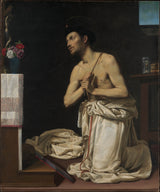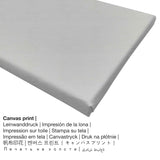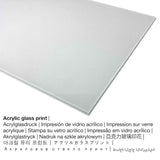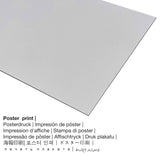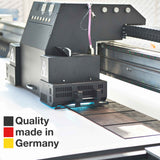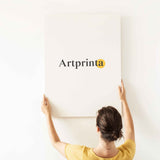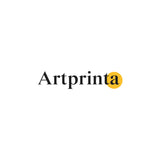Filippo Tarchiani, 1607 - Saint Dominic na Penitence - mbipụta nka mara mma
Ụtụ gụnyere. Mbupu gbakọrọ na ndenye ọpụpụ.
Nkọwapụta ngwaahịa
a 17th narị afọ ihe omimi Saint Dominic in Penitence kere site na nwoke painter Filippo Tarchiani. The painting has the size: 52 x 43 n'ime (132,1 x 109,2 cm) na e ji teknuzu nke mmanụ na kwaaji. What is more, the piece of art is part of the collection of Museumlọ ihe ngosi nka nke Obodo in New York City, New York, United States of America. With courtesy of: The Metropolitan Museum of Art, New York, Gift of Brian J. Brille, 2015 (nwere ikike - ngalaba ọha). Creditline of the artwork: Gift of Brian J. Brille, 2015. What is more, the alignment is Eserese ma nwee oke akụkụ nke 1: 1.2, nke pụtara na ogologo bụ 20% mkpụmkpụ karịa obosara. Filippo Tarchiani was a male painter of Italian nationality, whose artistic style was mainly Baroque. The Italian painter was born in the year 1576 na nwụrụ anwụ na afọ nke 69 na 1645.
Additional information as provided from The Metropolitan Museum of Art website (© - Ụlọ ihe ngosi nka nke obodo ukwu - Museumlọ ihe ngosi nka nke Obodo)
The thirteenth-century founder of the Dominican order is shown flagellating himself before an altar, his gaze fixed on a crucifix. The kneeling saint, painted in a muted, naturalistic style, is set against a geometric grid defined by the architecture and ecclesiastical furnishings. Although trained in the academic tradition of late-sixteenth-century Florentine art, Tarchiani made two prolonged visits to Rome where he studied the work of Caravaggio and Orazio Gentileschi. Between 1615 and 1616 he was employed on the same project as Orazio’s famous daughter, Artemisia Gentileschi, who arrived in Florence in 1613.
Tebụl a haziri ahazi nke mpempe nka
| Aha nka: | "Saint Dominic in Penitence" |
| Nhazi nka nka: | sere |
| Okwu nche anwụ: | nka ochie |
| Century: | 17th narị afọ |
| Afọ nka: | 1607 |
| Afọ nka: | karịa afọ 410 |
| Ihe osise izizi: | mmanụ na kwaaji |
| Akụkụ izizi (ọrụ nka): | 52 x 43 n'ime (132,1 x 109,2 cm) |
| Ụlọ ihe ngosi nka: | Museumlọ ihe ngosi nka nke Obodo |
| Ebe ngosi nka: | New York City, New York, Njikota Obodo Amerika |
| Ebe nrụọrụ weebụ ihe ngosi nka: | www.metmuseum.org |
| Ụdị ikike nka: | ngalaba ọha |
| Site n'aka: | The Metropolitan Museum of Art, New York, Gift of Brian J. Brille, 2015 |
| Ebe kredit nke ọrụ nka: | Gift of Brian J. Brille, 2015 |
Tebụl nkọwa omenkà
| Ihe nkiri: | Filippo Tarchiani |
| Aha utu aha: | Tarchiani, Filippo Tarchiani, Tarchiani Filippo |
| okike onye nka: | nwoke |
| Obodo onye nka: | Italian |
| Ọrụ: | onye na-ese ihe |
| Obodo obibi: | Italy |
| Nhazi nke onye nka: | nna ukwu ochie |
| Ụdị nke onye na-ese ihe: | Baroque |
| Ndụ: | 69 afọ |
| Afọ ọmụmụ: | 1576 |
| Afọ nwụrụ: | 1645 |
Ihe ndị a na-enye:
Na nhọrọ ndọpụta ngwaahịa ị nwere ike họrọ nha na ihe onwunwe dịka mmasị onwe gị si dị. Anyị na-ahapụ gị ka ịhọrọ n'ime ụdị ndị a:
- Kwaaji: The canvas print, not to be confused with an artwork painted on a canvas, is a digital copy printed on a UV direct printer. It has the distinctive look of three dimensionality. Further, a canvas produces a soft and positive effect. Canvas prints are relatively low in weight, meaning that it is easy to hang your Canvas print without extra wall-mounts. Therefore, a canvas print is suited for any type of wall.
- Ihe odide acrylic glass: An acrylic glass print, often described as a print on plexiglass, transforms your favorite original work of art into gorgeous home decoration. The artwork is being made with state-of-the-art UV direct printing technology. It creates impressive, intense print colors.
- Mbipụta nke aluminom: Aluminium Dibond prints are prints on metal with a true depth. A non-reflective surface structure make a fashionable impression. The Direct Print on Aluminum Dibond is your ideal introduction to the sophisticated world of fine prints with aluminum. For the Aluminium Dibond print, we print your artpiece on the surface of the white-primed aluminum composite. The bright & white parts of the work of art shimmer with a silky gloss, however without any glow.
- Mpempe akwụkwọ mmado ebipụtara na akwa akwa: A poster print is a printed flat cotton canvas paper with a slightly rough surface texture. Please keep in mind, that depending on the absolute size of the poster we add a white margin of something between 2-6 cm around the work of art in order to facilitate the framing.
Nkọwa edemede
| Nkewa ngwaahịa: | ezi nka mmeputakwa |
| Usoro mmeghari: | mmeputakwa n'ụdị dijitalụ |
| Usoro nhazi: | Mbipụta UV ozugbo |
| Production: | emepụtara na Germany |
| Stockdị ngwaahịa: | a na-achọ |
| Eji ngwaahịa a chọrọ: | ihe ndozi mgbidi, mgbidi gallery |
| Nhazi nka nka: | usoro eserese |
| Oke akụkụ: | 1: 1.2 |
| Pụtara nha onyonyo: | ogologo bụ 20% mkpụmkpụ karịa obosara |
| Nhọrọ akụrụngwa: | Mbipụta kwaaji, mbipụta ọla (aluminium dibond), mbipụta enyo acrylic (nwere ezigbo mkpuchi iko), mbipụta akwụkwọ mmado (akwụkwọ kwaaji) |
| Kanvas n'elu etiti ihe ndọtị (mbipụta akwa akwa): | 50x60cm - 20x24", 100x120cm - 39x47", 150x180cm - 59x71" |
| Mpempe iko acrylic (nwere ezigbo mkpuchi iko) nha: | 50x60cm - 20x24", 100x120cm - 39x47", 150x180cm - 59x71" |
| Mbipụta akwụkwọ mmado (akwụkwọ kwaaji): | 50x60cm - 20x24", 100x120cm - 39x47" |
| Nha ebipụta aluminium dibond: | 50x60cm - 20x24", 100x120cm - 39x47" |
| Nhazi mbipụta nka: | na-enweghị etiti |
Ederede iwu: We try whatever we can in order to describe our products as accurate as possible and to illustrate them visually in our shop. Although, the pigments of the print materials, as well as the printing may vary somehwat from the presentation on your device's monitor. Depending on the screen settings and the condition of the surface, not all colors are printed as exactly as the digital version on this website. Considering that the art reproductions are printed and processed by hand, there might as well be minor differences in the motif's exact position and the size.
© nwebiisinka | Artprinta.com (Artprinta)

